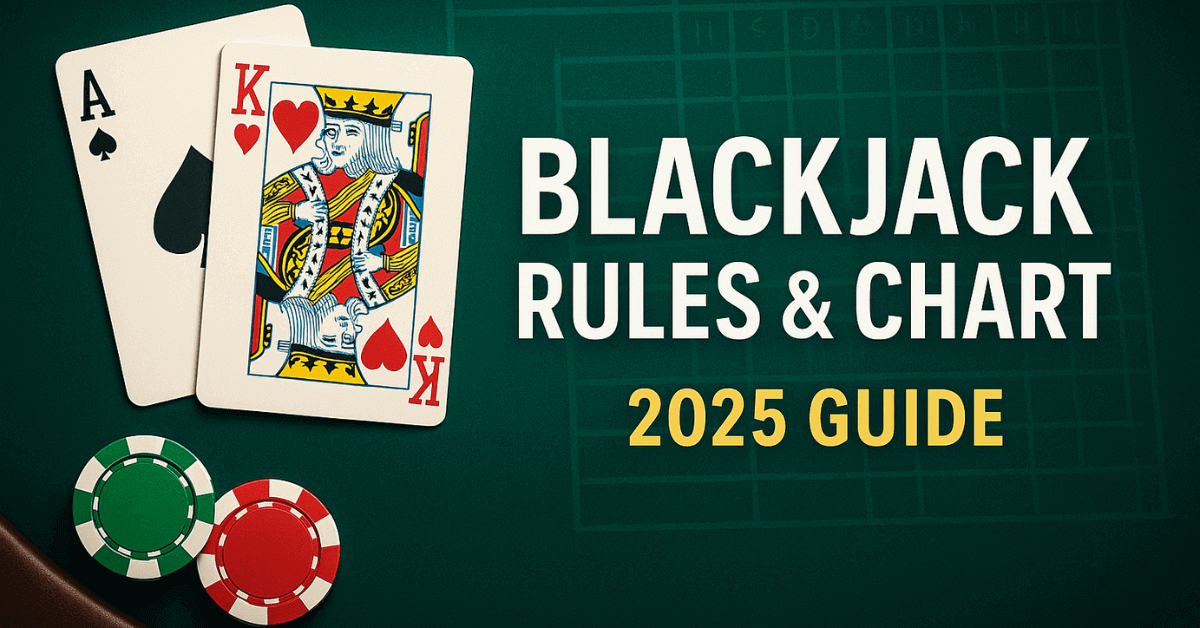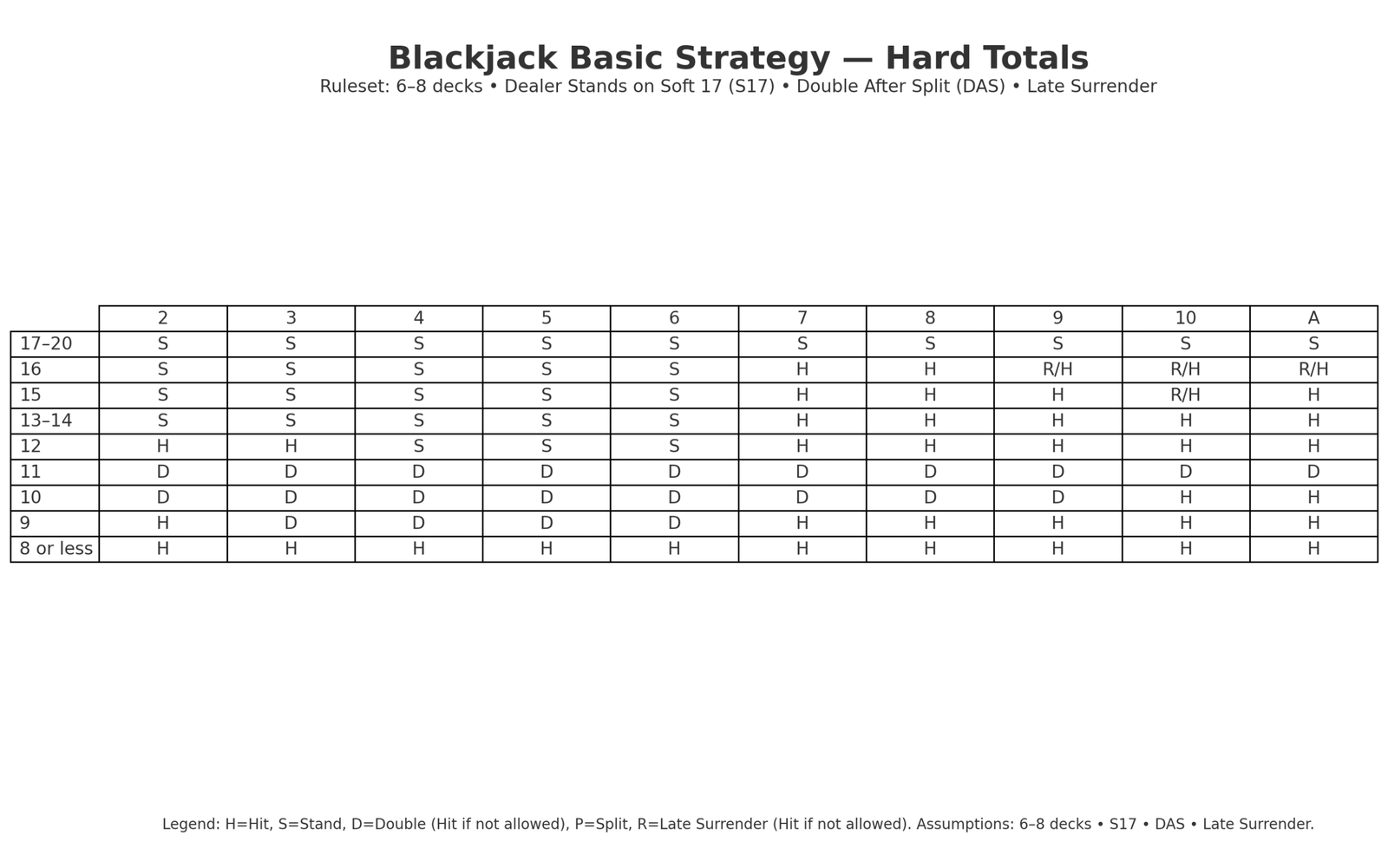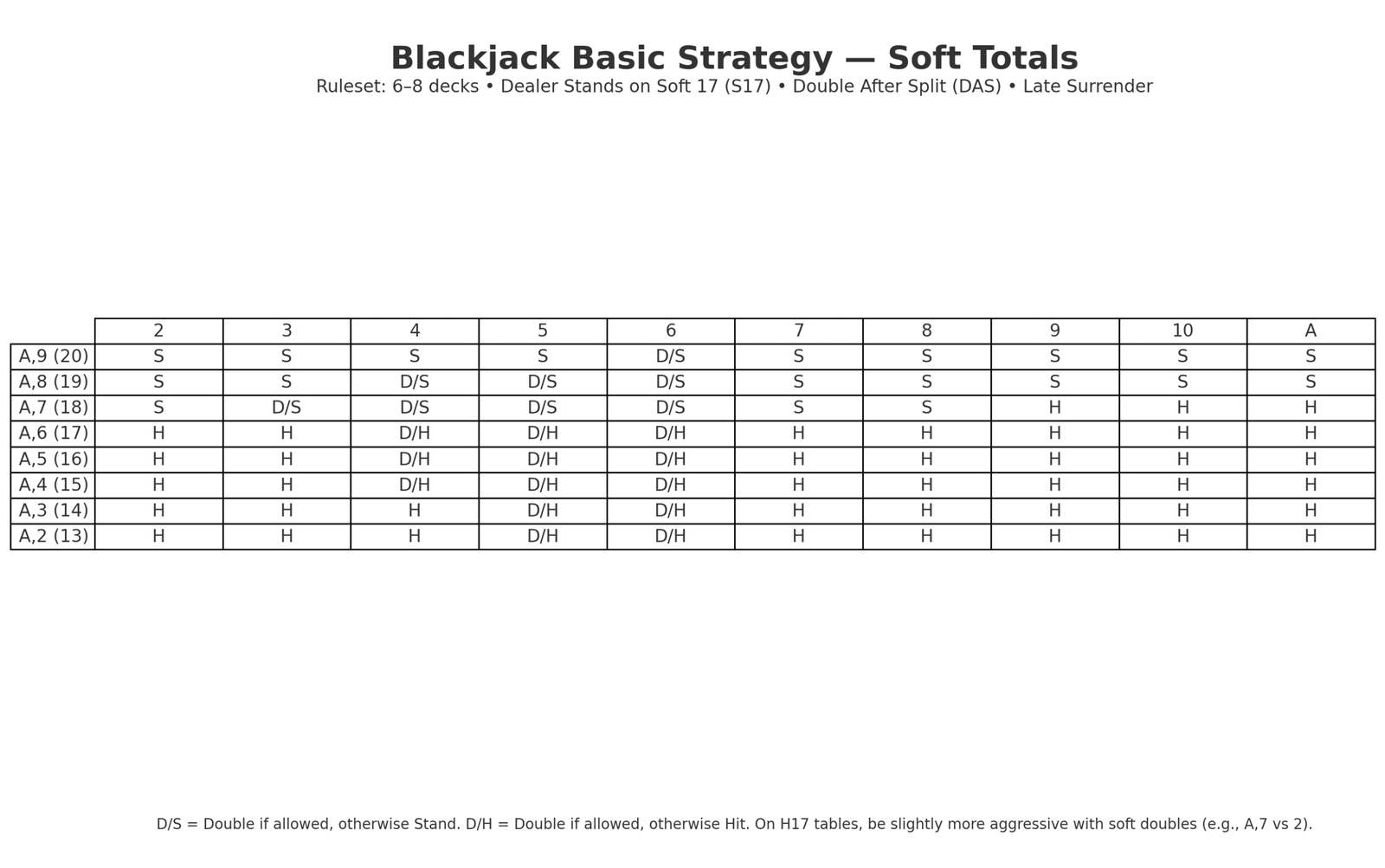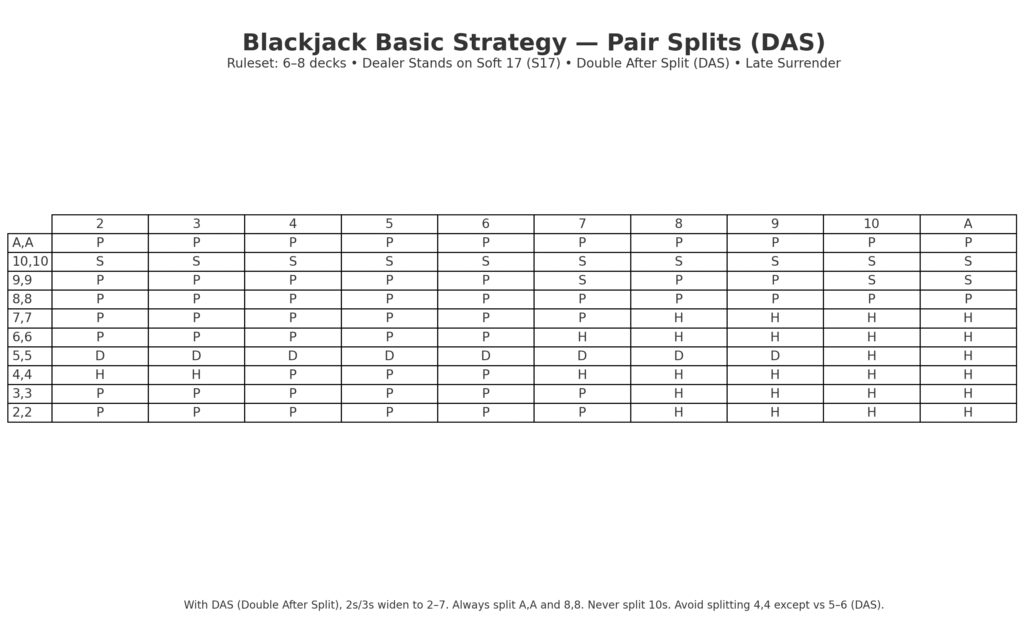
Master the blackjack rules, memorize a practical blackjack chart, and use a clean, step-by-step routine that keeps the house edge under 1% on good tables.
Blackjack Rules (Quick Start)
Blackjack rules in one minute: your goal is to beat the dealer by getting closer to 21 without busting. Number cards count as their value, face cards are 10, and Aces are 1 or 11—whichever helps your hand. A “blackjack” (Ace + 10-value as your first two cards) pays 3:2—avoid 6:5 tables. After you bet and receive two cards, choose to Hit, Stand, Double, Split, or Surrender (if offered) based on the dealer’s up-card.
The dealer then draws to 17+ using fixed rules (S17 = stands on soft 17; H17 = hits soft 17). Learn one basic strategy chart for your table’s ruleset and apply it every hand—consistent play under the correct blackjack rules keeps the house edge under 1% on good games.
- Objective: Beat the dealer by having a total closer to 21 without busting. This is the core of all blackjack rules you’ll apply.
- Card values: 2–10 = face value; J/Q/K = 10; Ace = 1 or 11 (whichever helps).
- Blackjack (natural 21): Ace + 10-value as the first two cards. Standard payout 3:2; avoid 6:5 tables—those increase the house edge.
- Player goes first: You act before the dealer, then the dealer draws under fixed blackjack dealer rules (usually to 17+).
- Available actions: Hit, Stand, Double, Split, Surrender (if allowed).
- Table rules matter: Look for S17 (dealer stands on soft 17), DAS (double after split), Late Surrender, and 3:2 payout. These settings materially reduce house edge.
Pro tip: Commit one blackjack chart to memory for a specific ruleset (e.g., 6–8 decks, S17, DAS, late surrender). You’ll play faster and more accurately.
For a deeper primer on core blackjack rules and hand values, see this concise guide from Casino News Daily.
How to Play Blackjack (Step-by-Step)
To learn how to play blackjack, start by buying in and placing your bet within your plan. You receive two cards face up; the dealer gets one up-card (and a hole card in peek games). If you have a blackjack (Ace + 10-value), you’re paid 3:2 unless the dealer also has one.
Otherwise, act in turn: Hit or Stand according to your blackjack chart, Double to add one extra bet for exactly one card when the math favors you, Split matching pairs into two hands (often with Double After Split), or Surrender early to forfeit half when the spot is statistically bad. After all players act, the dealer reveals and must draw to 17+ per house blackjack rules (S17/H17). Hands are compared: higher total ≤21 wins, equal totals push, and busts lose immediately.
- Buy-in & bet an initial stake within your bankroll plan.
- Initial deal: You get two cards face up; dealer gets one up-card and one down-card (in EU “ENHC” games the dealer may not take a hole card yet—see variants below).
- Check for naturals: If you have a blackjack and the dealer doesn’t, you’re paid 3:2 immediately.
- Your decisions: Follow the blackjack chart to hit/stand/double/split/surrender based on your total vs the dealer’s up-card.
- Dealer’s turn: Dealer reveals hole card (or draws to it in ENHC) and must draw until 17+ according to house blackjack dealer rules (S17 or H17).
- Compare hands: Higher total ≤21 wins; equal totals push; busts lose immediately.
Table etiquette & signals (helps live & video tables):
- Tap the felt for Hit, wave palm horizontally for Stand, place an equal chip next to your bet for Double/Split (verbalize too).
- Don’t touch cards on face-up games; keep phones off the layout; stack chips highest denomination on bottom.
To see how live tables are presented in a licensed lobby, browse the Betsafe Live Blackjack selection.
Player Actions & Dealer Rules (Deeper)
Hit: Take a card; use when chart shows you’re statistically behind (e.g., hard 12 vs 2–3 often a hit or stand depending on rules).
Stand: Lock your total; you do this more often against weak dealer up-cards (2–6) when your total is 12+.
Double (down): Double your wager, take exactly one card. Best used when you have more ways to improve than to bust (e.g., hard 11 vs anything; hard 10 vs 2–9; soft A,6–A,8 vs 3–6).
Split: Turn a pair into two hands. Always split A,A and 8,8; never split 10s. DAS widens profitable splits.
Surrender (late): Give up half your bet before drawing; valuable on 16 vs 9/10/A and 15 vs 10.
Dealer rules variants:
- S17 vs H17: On H17 (dealer hits soft 17), the house edge rises; your blackjack chart gets a bit more aggressive on soft doubles (e.g., A,7 vs 2).
- Peek vs No-Peek (ENHC): In US games the dealer peeks for blackjack with A/10 showing. In ENHC (European No Hole Card) games, the dealer doesn’t take a hole card until after players act—this affects doubles/splits versus a dealer Ace/10 because you can lose multiple bets to a dealer natural. Many ENHC tables restrict doubles/splits in those spots.
If you’re unsure which rules your table uses (S17 vs H17, ENHC, DAS), check the 888casino’s blackjack rules by variant for quick comparisons.
Payouts, Insurance & Surrender (Clarity that Saves Money)
Smart payouts start with table selection: standard wins pay 1:1, but a natural blackjack (Ace + 10-value) should pay 3:2—avoid 6:5 tables because they quietly raise the house edge under otherwise fair blackjack rules. “Even money” on your blackjack when the dealer shows an Ace is just insurance by another name; both are negative-EV bets long term, so skip them.
Use late surrender as a safety valve on mathematically bad spots—typically hard 16 vs 9/10/A and hard 15 vs 10—where you forfeit half your stake and preserve bankroll for better hands. Keep these three levers straight (3:2 only, no insurance/even money, disciplined surrender) and your strategy chart does the rest.
- Wins: 1:1; Blackjack: 3:2 (avoid 6:5).
- Even money: If you have a blackjack and dealer shows Ace, “even money” is just insurance—decline it (negative expectation).
- Insurance: Side bet that the dealer has blackjack when showing Ace; long-term losing proposition; skip it.
- Late Surrender (LS): Smart safety valve. Use on hard 16 vs 9/10/A and 15 vs 10; otherwise play out the hand.
House Edge & Bankroll Tips (Realistic & Usable)
On good tables (3:2 payout, S17, DAS, late surrender), perfect basic play puts the house edge around 0.4–0.6%; H17 nudges it higher. Size your bankroll at 30–50× your average bet (e.g., €10 bets → €300–€500) and stick to flat stakes or a gentle 1–2 spread—no Martingale. Set session rails: a +20–40% win target and –30–50% stop-loss, then walk.
Variance guarantees swings even when you follow the blackjack chart, so never chase losses. For non-counters, game selection matters more than “feel”: pick 3:2, S17, DAS, late surrender, and re-split aces if possible. These table settings—plus disciplined bankroll rules—do more for you than any hunch under the blackjack rules.
- Good tables (6–8 decks, S17, DAS, LS, 3:2) with basic strategy: ~0.5% house edge (H17 nudges higher).
- Bankroll sizing: Bring 30–50× your average bet for a regular session; more if you plan to use small bet ramps.
- Stake plan: Flat bet or gentle 1–2 spread; avoid steep chase increases that trigger tilt or table scrutiny.
- Session management: Pre-set win target (e.g., +20–40% of buy-in), stop-loss (−30–50%), and time breaks to keep decisions disciplined.
- Game selection checklist: 3:2 payout • S17 • DAS • LS • Re-split allowed (ideally RSA for Aces) • Reasonable table mins.
Blackjack Chart — Basic Strategy (S17 • DAS • Late Surrender)
Assumptions: 6–8 decks, dealer Stands on Soft 17 (S17), Double After Split (DAS) allowed, Late Surrender available.
Legend: H = Hit, S = Stand, D = Double (H if not allowed), P = Split, R = Surrender (H if not allowed).

1. Hard Totals
| Player \ Dealer | 2 | 3 | 4 | 5 | 6 | 7 | 8 | 9 | 10 | A |
|---|---|---|---|---|---|---|---|---|---|---|
| 17–20 | S | S | S | S | S | S | S | S | S | S |
| 16 | S | S | S | S | S | H | H | R/H | R/H | R/H |
| 15 | S | S | S | S | S | H | H | H | R/H | H |
| 13–14 | S | S | S | S | S | H | H | H | H | H |
| 12 | H | H | S | S | S | H | H | H | H | H |
| 11 | D | D | D | D | D | D | D | D | D | D |
| 10 | D | D | D | D | D | D | D | D | H | H |
| 9 | H | D | D | D | D | H | H | H | H | H |
| 8− | H | H | H | H | H | H | H | H | H | H |
Notes:
- R/H = Surrender if offered; otherwise Hit.
- Composition tip: A 16 made of 9+7 performs slightly better than 10+6; surrender/stand decisions remain chart-driven to avoid errors.

2. Soft Totals
| A + | 2 | 3 | 4 | 5 | 6 | 7 | 8 | 9 | 10 | A |
|---|---|---|---|---|---|---|---|---|---|---|
| A,9 (20) | S | S | S | S | D/S | S | S | S | S | S |
| A,8 (19) | S | S | D/S | D/S | D/S | S | S | S | S | S |
| A,7 (18) | S | D/S | D/S | D/S | D/S | S | S | H | H | H |
| A,6 (17) | H | H | D/H | D/H | D/H | H | H | H | H | H |
| A,5 (16) | H | H | D/H | D/H | D/H | H | H | H | H | H |
| A,4 (15) | H | H | D/H | D/H | D/H | H | H | H | H | H |
| A,3 (14) | H | H | H | D/H | D/H | H | H | H | H | H |
| A,2 (13) | H | H | H | D/H | D/H | H | H | H | H | H |
H17 adjustment: On H17 tables, double a little more aggressively with A,7 vs 2 (and sometimes A,8 vs 6) because the dealer makes 17s more often.

3. Pair Splits (DAS)
| Pair | 2 | 3 | 4 | 5 | 6 | 7 | 8 | 9 | 10 | A |
|---|---|---|---|---|---|---|---|---|---|---|
| A,A | P | P | P | P | P | P | P | P | P | P |
| 10,10 | S | S | S | S | S | S | S | S | S | S |
| 9,9 | P | P | P | P | P | S | P | P | S | S |
| 8,8 | P | P | P | P | P | P | P | P | P | P |
| 7,7 | P | P | P | P | P | P | H | H | H | H |
| 6,6 | P | P | P | P | P | H | H | H | H | H |
| 5,5 | D | D | D | D | D | D | D | D | H | H |
| 4,4 | H | H | P | P | P | H | H | H | H | H |
| 3,3 | P | P | P | P | P | P | H | H | H | H |
| 2,2 | P | P | P | P | P | P | H | H | H | H |
Variant reminders: Without DAS, narrow 2s/3s splits; many ENHC games disallow doubling after splits anyway.
These charts follow mainstream basic strategy; for glossary terms and regional differences, Casino.Guru’s blackjack rules & strategy page is a solid reference.
Double Down & Split: Pro Tips (Beyond the Grid)
When the math says press, double down; when two weak cards can become two winners, split—but do it with discipline. Your highest-EV doubles are hard 11 vs 2–A, hard 10 vs 2–9, and hard 9 vs 3–6; with soft hands, target A,7/A,6 vs 3–6 (slightly widen on H17 tables).
Treat 5,5 as a strong 10 and double instead of splitting; 4,4 is a split only vs 5–6 with DAS. Always split A,A and 8,8; never split 10s—two 20s beat the “but 21 is close” temptation. 9,9 is the nuance hand: split vs 2–6 and 8–9, but stand vs 7/10/A.
Check house rules: many venues give only one card to split Aces and may limit resplits; ENHC games can punish aggressive doubles/splits vs dealer Ace/10. When in doubt, defer to your blackjack chart and let the numbers—not hunches—drive the move.
- Power doubles: Hard 11 vs 2–A; hard 10 vs 2–9; hard 9 vs 3–6.
- Soft doubles (S17): A,7 vs 3–6; A,6 vs 3–6; A,4/5 vs 4–6; A,2/3 vs 5–6. Expand slightly on H17.
- Surrender discipline: Hard 16 vs 9/10/A; 15 vs 10 (LS only).
- Best splits: Always A,A and 8,8. 9,9 split vs 2–6 and 8–9 (stand vs 7/10/A).
- Avoid: Splitting 10s; splitting 4,4 except vs 5–6 (DAS); splitting 5,5 (that’s a strong 10 to double).
Common Mistakes to Avoid (Costly but Easy to Fix)
Even solid players leak money through a few predictable habits—and the fix is simple once you see them. The biggest drains are playing 6:5 tables, taking insurance/even money, and ignoring how H17 vs S17 tweaks the math. Next come execution errors: misplaying soft totals (A,7 and A,6), splitting 10s, skipping late surrender on awful spots (16 vs 10/A), and freelancing instead of following your blackjack chart.
Add in bankroll mistakes—overbetting after losses, no stop-loss or win target—and thin edges vanish. This section spotlights each trap and gives you the quick correction so you can apply the right blackjack rules automatically.
- Playing 6:5 tables: A silent house-edge killer. Scout for 3:2.
- Taking insurance or even money: Mathematically negative; skip it.
- Ignoring blackjack rules variants: H17, no surrender, no DAS, ENHC all degrade returns and change parts of the blackjack chart.
- Over-betting after losses: Emotional tilt erases thin edges; stick to your plan.
- Guessing on soft totals/pairs: Most human leaks happen with A,7 / A,6 and pair splits—drill them.
Practice Drills (10 Minutes to Fluency)
Set a 10-minute timer and run four micro-drills that hard-wire the blackjack chart. First, do column call-outs (4 min): pick one dealer up-card (6, then 10, then A) and say the action for 20 random hands out loud—Hit/Stand/Double/Split/Surrender.
Next, a soft-hand ladder (3 min): cycle A,2 → A,9 vs 2–A, focusing on “D/H” and “D/S.” Then, pair patterns (2 min): chant the rules—“Always A,A & 8,8; never 10s; 9s split vs 2–6 & 8–9; stand vs 7/10/A.” Finish with a variant toggle (1 min): name the two changes you’d make on H17 vs S17 (e.g., double A,7 vs 2 more often). If any spot takes over 3 seconds, star it on your printed blackjack chart and repeat tomorrow—automaticity beats memory under real blackjack rules.
- Column call-outs (4 mins): Print the blackjack chart, cover dealer 6 column, call the action for 30 random hands; repeat on dealer 10 and Ace.
- Soft-hand sprints (3 mins): Cycle A,2 → A,9 against 2–A, speaking “D/H” or “D/S” aloud.
- Pairs patterning (2 mins): Recite “Always A,A & 8,8 — Never 10s — 9s split except 7/10/A.”
- Variant micro-drill (1 min): Name two changes you’d make on H17 vs S17 (e.g., A,7 vs 2 double more).
Bonus Section: Rule Variants That Change Your Chart
- H17 (dealer hits soft 17): Slightly worse for players; expand soft doubles (A,7 vs 2).
- ENHC (no hole card): Don’t double/split freely vs dealer Ace/10 if your table rules forfeit multiple bets to a dealer natural; many ENHC games forbid those actions anyway.
- RSA (resplit aces): Player-friendly; allows more EV from A,A splits.
- Double restrictions: Some tables limit doubles to 9–11 only—your blackjack chart must tighten soft doubles and some hard 10s.
FAQ
What are the official blackjack rules?
Get as close to 21 as possible without busting; dealer draws to 17 per house rules. Use a blackjack chart matched to your table (S17/H17, DAS, surrender) for every decision.
What is soft 17?
A soft total includes an Ace counted as 11 (e.g., A,6). S17 means the dealer stands on soft 17; H17 means the dealer hits it—worse for players and slightly shifts basic strategy.
When should I double down in blackjack?
Hard 11 vs 2–A, 10 vs 2–9, 9 vs 3–6, plus soft doubles A,7/A,6 vs 3–6 (with tweaks on H17). See Sections 6–7.
Are “doubledown promo codes” related to blackjack?
No. “Double down” (game move under blackjack rules) ≠ “DoubleDown Casino” promo codes (social casino offers). Different context entirely.
Is card counting illegal?
Generally not illegal, but casinos can refuse service. This guide focuses on basic strategy, which is welcomed everywhere.
Final Words
If you remember one thing, make it this: consistency beats hunches. Play only good games (3:2 payout, S17, DAS, late surrender), follow the blackjack rules and your blackjack chart every hand, and protect your bankroll with firm stop-loss/win targets. Ten minutes of drills a day turns hesitation into automatic, +EV decisions. Grab the printable chart PDF, bookmark this guide, and revisit the soft-hand and pair spots until they’re second nature. Most of all, keep it fun and responsible—step away when the plan says so, not when emotion does.
Download: Printable Blackjack Chart (PDF)
Grab the one-page blackjack chart that matches this guide’s blackjack rules (6–8 decks, S17, DAS, Late Surrender). It includes the Hard Totals, Soft Totals, and Pair Splits tables on a single A4 page, plus a quick legend and H17 tweak notes so you always know when to double, stand, hit, split, or surrender.
What’s inside
- Hard / Soft / Pairs charts (S17 • DAS • Late Surrender)
- Quick legend: H, S, D, P, R (and D/H, D/S)
- H17 adjustments at a glance
- Print tips for table play
Print tips: set to A4, portrait, 100% scale, and “print backgrounds” ON. Keep a spare at home and a folded copy in your wallet.
Download the Blackjack Basic Strategy – 1-Page PDF
Use responsibly. The chart is for educational use and assumes standard multi-deck rules; always check your table rules before relying on any chart.